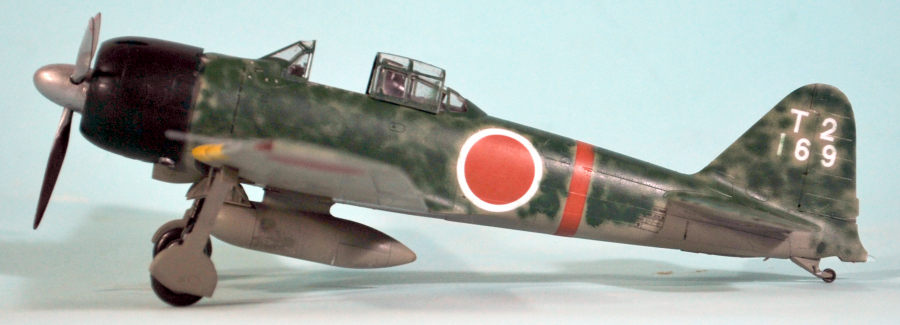
Eduard 1/48 A6M3 model 32
| KIT #: | 82213 |
| PRICE: | $52.95 |
| DECALS: | Five options |
| REVIEWER: | Tom Cleaver |
| NOTES: |

| HISTORY |
The A6M2 Model 21 Zero revealed it was slightly underpowered when it entered combat in 1941. Mitsubishi answered this problem with the A6M3, powered by an uprated Sakae 21 engine, which used a two-speed supercharger for better altitude performance, and increased power to 1,130 hp. A prototype with the new engine was first flown on July 15, 1941. The new engine was slightly heavier and somewhat longer due to the larger supercharger, which moved the center of gravity too far forward on the existing airframe. To correct for this, the engine mountings were cut back by 7.3 inches, which reduced the size of the main fuselage fuel tank located between the engine and the cockpit from 137 gallons to 120 US gallons. The cowling was redesigned to enlarge the cowl flaps, revise the oil cooler air intake, and move the carburetor air intake above the engine in the upper half of the cowling.
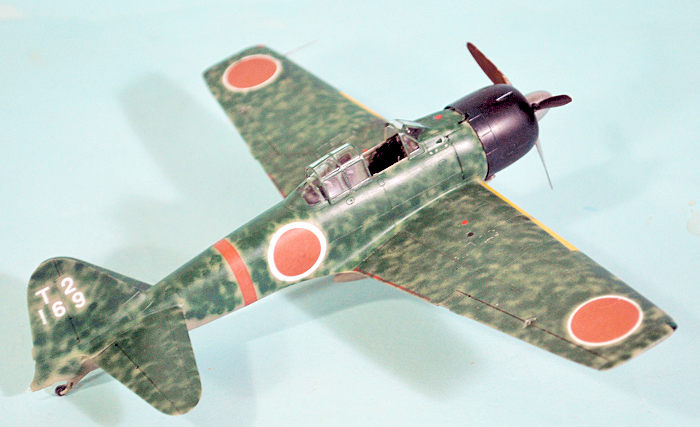 The Model
32 featured a redesigned wing with the folding tips removed, which squared off
the wingtips. The inboard edge of the aileron was moved outboard by one rib, and
the wing fuel tanks were enlarged to 110 gallons. The 20 mm cannons were
upgraded from the Type 99 Mark l to the Type 99 Mark II, while ammuntion
capacity was increased to 100 rpg.
The Model
32 featured a redesigned wing with the folding tips removed, which squared off
the wingtips. The inboard edge of the aileron was moved outboard by one rib, and
the wing fuel tanks were enlarged to 110 gallons. The 20 mm cannons were
upgraded from the Type 99 Mark l to the Type 99 Mark II, while ammuntion
capacity was increased to 100 rpg.
The changes increased maximum speed by only 6.8 mph compared to the Model 21, but reduced maximum range by approximately 620 miles. The shorter wing span led to better roll, while reduced drag allowed diving speed to be increased to 420 mph. Maneuverability suffered due to smaller ailerons and decreased lift, while range suffered due to greater fuel consumption. Nevertheless, the navy accepted the new type and it entered production in April 1942. Mitsubishi produced only 343 before it was replaced by the A6M3 Model 22, which restored the Model 21 wing and the maneuverability and better range than the A6M2.
The reduced range proved a significant limitation during the Solomons Campaign, where Zeros based at Rabaul had to fly nearly to their maximum range to reach Guadalcanal and return. Thus, the Model 32 initially entered combat over New Guinea, where it replaced the Model 21s of the Tainan Air Group based at Lae and Salamaua. The lack of range spurred the Japanese to construct airfields on Bougainville, the northernmost island of the Solomons chain, which allowed the Model 32 to be widely used during the Central Solomons campaign that commenced after the U.S. took control of Guadalcanal. The new type equipped the carrier air groups of the ships at Truk, and saw combat at both the Battle of the Eastern Solomons and the Battle of Santa Cruz. They were pressed into service at Rabaul and saw extensive combat during the Rabaul campaign between September 1943 and February 1944.
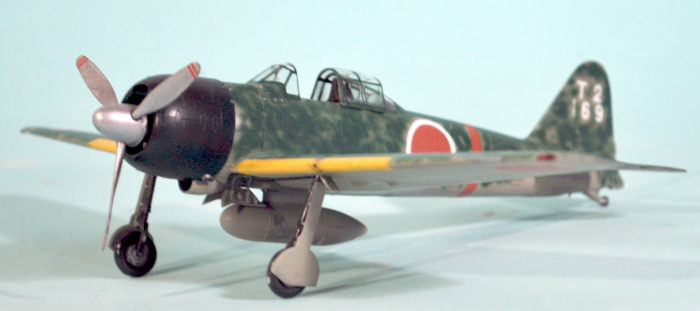 The
initial appearance of the redesigned A6M3 Model 32, which was initially thought
to be a completely new type, prompted the USAAF to assign it a new code name,
"Hap". The name was short-lived, as a protest from USAAF Commanding General
Henry "Hap" Arnold forced a change to "Hamp". Soon after, it was realized it was
simply a new model of the "Zeke" and was termed "Zeke 32".
The
initial appearance of the redesigned A6M3 Model 32, which was initially thought
to be a completely new type, prompted the USAAF to assign it a new code name,
"Hap". The name was short-lived, as a protest from USAAF Commanding General
Henry "Hap" Arnold forced a change to "Hamp". Soon after, it was realized it was
simply a new model of the "Zeke" and was termed "Zeke 32".
Leading Seaman Kenji Yanagiya was the only one of the six Zero pilots escorting Admiral Yamamoto’s G4M1 on his inspection tour of the South Pacific on April 18, 1943, to survive the war.
Importantly, Yanagiya gave an account of the battle which was conclusive in demonstrating that Thomas G.Lanphier Jr. could not have been the pilot who shot down Yamamoto’s airplane as he had long claimed, and that Rex Barber deserved full credit for downing the Admiral’s airplane. Air Force records were changed in recognition of Yanagiya’s information in 2006, but as usual, many “hairplane hexpurtz” are not up to date in their information and still believe Lanphier’s long-disproven claim.
| THE KIT |
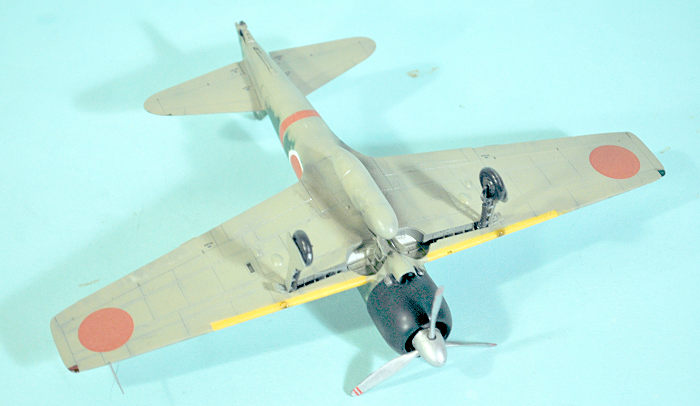 This is
the second Zero sub-type released by Eduard. The kit has a separate Spru V that
has the type-specific parts, which include a different rudder, engine and
cowling. The wing sprue is also new. Surface detail is petite and highly
detailed, as one is now accustomed to seeing on Eduard kits. The decal sheet
includes markings for five aircraft, including the Zero flown by Kenji Yanagiya
at the Yamamoto Interception; an airplane from the Tainan Air Group at Buna, Mew
Guinea; an airplane from the 3rd Kokutai at Timor; an airplane from the Zuikaku
Fighter Squadron at the Battle of Santa Cruz; and an airplane flown by Takeo
Tanimizu on Taiwan in September 1944.
This is
the second Zero sub-type released by Eduard. The kit has a separate Spru V that
has the type-specific parts, which include a different rudder, engine and
cowling. The wing sprue is also new. Surface detail is petite and highly
detailed, as one is now accustomed to seeing on Eduard kits. The decal sheet
includes markings for five aircraft, including the Zero flown by Kenji Yanagiya
at the Yamamoto Interception; an airplane from the Tainan Air Group at Buna, Mew
Guinea; an airplane from the 3rd Kokutai at Timor; an airplane from the Zuikaku
Fighter Squadron at the Battle of Santa Cruz; and an airplane flown by Takeo
Tanimizu on Taiwan in September 1944.
| CONSTRUCTION |
 Eduard’s
Zeros are less “fiddly” than some of the other kits. I have found that any
remaining “fiddliness” can be dispensed with if one assembles the cockpit as
follows: glue the side frames to each fuselage half rather than to the cockpit
floor; this allows all the small detail parts to be positioned more easily.
Assemble the main cockpit - the forward firewall, floor, rear bulkhead, controls
and seat as per the kit instructions, then glue that full assembly to one or the
other fuselage side and get it positioned properly. Follow the kit instructions
for assembly and placement of the ammo magazines and guns, and the instrument
panel.
Eduard’s
Zeros are less “fiddly” than some of the other kits. I have found that any
remaining “fiddliness” can be dispensed with if one assembles the cockpit as
follows: glue the side frames to each fuselage half rather than to the cockpit
floor; this allows all the small detail parts to be positioned more easily.
Assemble the main cockpit - the forward firewall, floor, rear bulkhead, controls
and seat as per the kit instructions, then glue that full assembly to one or the
other fuselage side and get it positioned properly. Follow the kit instructions
for assembly and placement of the ammo magazines and guns, and the instrument
panel.
Past that, follow the kit instructions for assembly of the airframe and you cannot go wrong. Be careful in assembly and you will not use any filler anywhere.
| COLORS & MARKINGS |
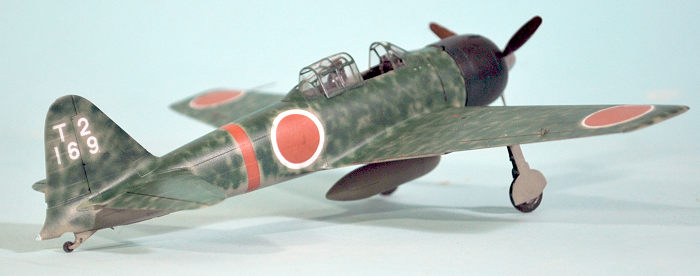 Yanagiya’s
Zero had an overpainted upper camouflage of a dark green “scribble.” To get
this, I first painted the model in Mitsubishi Ameiro tan, applied clear gloss,
then applied the decals. When they were set, I applied another coat of clear
gloss, then airbrushed the upper camo freehand around the markings, using Tamiya
XF-70 IJN Dark Green 2 (aka “Mitsubishi Dark Green. I thinned the paint 50-50
which allowed me to tighten down the airbrush so that I got a thin line. I then
“scribbled” over the upper surfaces until I had an effect that looked like the
boxart. I got a slight bit of overspray, which was intended.
Yanagiya’s
Zero had an overpainted upper camouflage of a dark green “scribble.” To get
this, I first painted the model in Mitsubishi Ameiro tan, applied clear gloss,
then applied the decals. When they were set, I applied another coat of clear
gloss, then airbrushed the upper camo freehand around the markings, using Tamiya
XF-70 IJN Dark Green 2 (aka “Mitsubishi Dark Green. I thinned the paint 50-50
which allowed me to tighten down the airbrush so that I got a thin line. I then
“scribbled” over the upper surfaces until I had an effect that looked like the
boxart. I got a slight bit of overspray, which was intended.
After giving some slight “dings” to the model and airbrushing exhaust staining and gunfire stains, I assembled the landing gear and attached it, unmasked the canopy and attached the sliding section in the open position. I attached the prop and called things done.
| CONCLUSIONS |
Eduard’s Zeros are the best in 1/48, as are their 109s, 109s, P-51Ds, and Spitfires. If you take your time, follow the instructions, and are careful in assembly, you will not need filler anywhere and you will be rewarded with a very nice result.
Recommended for modelers with experience assembling precisely-designed kits.
15 December 2022
Copyright ModelingMadness.com. All rights reserved. No reproduction in part or in whole without express permission.
Review kit courtesy of Eduard.
If you would like your product reviewed fairly and fairly quickly, please contact the editor or see other details in the Note to Contributors.